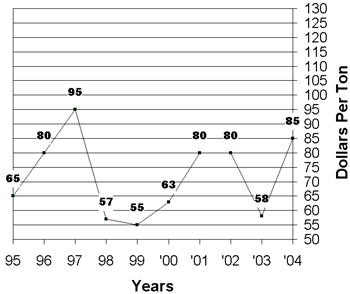Production Update:
Irrigation timing: Alfalfa is most susceptible to water stress
immediately after cutting. Irrigating as soon as possible after cutting
or applying the previous irrigation later in the cutting cycle can promote
early growth. However, irrigating too soon after cutting before some regrowth
has occurred can lead to scald damage if temperatures are over 100 degrees
and the soil is saturated for more than 30 hours. Also, irrigating too
late in the irrigation cycle can result in soil compaction and permanently
damage the alfalfa stand. Nevertheless, with these constraints in mind,
encouraging early growth by irrigation management will result in greater
productivity
Insect Management: Webworms (picture),
such as alfalfa webworm, beet webworm and garden webworm, are occasionally
found in desert alfalfa. The larvae of these small moths are slender,
usually greenish yellow, stripped or spotted caterpillars which may reach
an inch in length. The larvae devour leaves beneath silken webs on alfalfa
leaves. They may be found on the upper parts of plants in summer and fall.
They are not known to cause serious economic damage. Harvesting the infested
hay usually greatly reduces the numbers in the next crop cycle.
Weed Control: Balan and Eptam are the only preplant herbicides
registered on alfalfa. Trifluralin has reduced new stands by 40 to 60
percent in our tests. Prowl in not registered on alfalfa and has also
hurt new stands in our tests except where it was mechanically incorporated
prior to planting
| Market Summary |
High
|
Low
|
Average
|
Off grade
|
| Past 2 Weeks ( 2004) |
90
|
80
|
85
|
70-80
|
| Last Year ( 2003) |
65
|
50
|
58
|
40-50
|
10 Year Summary (July 27, to August 9, 1995-2004):

Issued in furtherance of Cooperative Extension work, acts of May 8 and June 30, 1914, in cooperation with the U.S. Department of Agriculture, James A. Christenson, Director Cooperative Extension, College of Agriculture and Life Sciences, The University of Arizona.
The University of Arizona is an equal opportunity, affirmative action institution. The University does not discriminate on the basis of race, color, religion, sex, national origin, age, disability, veteran status, or sexual orientation in its programs and activities.
Any products, services, or organizations that are
mentioned, shown, or indirectly implied in this web document do not imply
endorsement by The University of Arizona.
Information provided by:
Barry Tickes, btickes@ag.arizona.edu Extension Agent, Yuma County
Michael Ottman, mottman@ag.arizona.edu Agronomy Specialist
College of Agriculture, The University of Arizona.
Eric Natwick, etnatwick@ucdavis.edu UCCE Imperial County - Farm Advisor
University of California, Davis, CA.
Forages: Crop Mgmt | Soil Mgmt | Irrigation | Alfalfa Reports | Insects | Diseases | Weeds | Pesticides
Home | Other Crops | Forages
For more Arizona Production Ag Information:
Home | Cotton | Veggies| Forages | Grains | Citrus | Crop x Crop | Insects | Diseases| Weeds | Pesticides | News | Weather | Research | Photos | Contacts | General Info. | Site Map
Copyright © 2001 University of Arizona,
College of Agriculture and Life Sciences
Webmaster: Al Fournier (fournier@ag.arizona.edu)